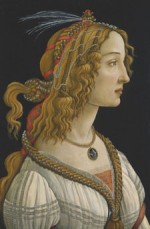Column Name
Title
Today we take portrait painting for granted, but from the end of the Classical period in Greece and Rome up to the 14th century, there were few, if any portraits as such. The Renaissance saw the flourishing of portraiture in all kinds of media. Indeed, “The Renaissance Portrait from Donatello to Bellini,” which is at the Metropolitan Museum of Art through March 18, features a great variety; included are paintings, drawings, manuscript illustrations, sculpture, and medallions. Ordinarily, you would have to travel to France, Germany, the Netherlands, Italy, and the United States to find the works included in this one gorgeous and comprehensive exhibition.
Body
One of my favorite works in the exhibit is by Domenico Ghirlandaio (1448/49-1494), a painter from Florence. In it, a cauliflower-nosed man clad in a bright red fur-lined robe glances tenderly at an angelic-looking boy whose blond curls cascade neatly from a red cap. The child looks up to meet his grandfather’s gaze admiringly, and the truthfulness and psychological insight the painter shows in depicting the obliviousness of the child to the old man’s deformity make the painting especially moving. The picture, completed in about 1490, and painted in tempera on wood, is on loan from the Louvre; it is one of about 160 portraits in this extraordinary show. Indeed, loans for this one-time event come from many museums all over Europe and the United States.
When I was in graduate school, Ghirlandaio was relegated to a somewhat lower status than the “great” Renaissance painters because he “merely” depicted social history; but this is exactly what makes him memorable. You feel as if you might have met these people if you could travel back in time and place.
Still, what a leap it is to the equally moving, but much different and far less “truthful” portraits by the great Sandro Botticelli! The most stunning one in the exhibition is that of Simonetta Vespucci, called Ideal Portrait of a Lady (1475-80), which is on loan from Frankfurt’s Städel museum. This incredibly delicately chiseled and sparkling beauty is thought to not at all resemble the historical person named in the painting. Her voluminous, voluptuous hair, braided with jewels is both improbable and symbolic. The placid lines of her profile are set against a dark background and were no doubt meant as an ideal personification of the city of Florence, birthplace of eternal beauty. Some say that this Simonetta appeared in all of Botticelli’s works (and so, by implication, she would have been the source for two of the artist’s most renowned paintings, Primavera and The Birth of Venus).
This exhibition illustrates beautifully the growing concepts of humanism and celebration of individualism during the Renaissance. The show is divided into three major sections, spanning about eight decades. It begins in Florence, which was one of the largest and wealthiest cities in Europe during the 15th century. The Met show goes on to look at works from Ferrara, Mantua, Bologna, Milan, Urbino, Naples, and Rome. A separate room dedicated to Venice, where a tradition of portraiture arose later than in the other cities, ends the exhibit.
The artists featured range from the very famous—Botticelli, Donatello, Mantegna, and Bellini—to lesser-known painters. The subjects include royalty and commoners, members of illustrious families (such as the Medicis, Gonzagas, and Estes, for instance), religious leaders, politicians, poets, and artists. They are old and young, male and female, beautiful and ugly. Some are depicted so realistically that they look as if they could walk right out of the picture. Others were meant to be symbolic—of a type, an ideal. And others were painted to record a likeness or a ritual (matrimonial portraits, for instance).
A work that has attracted the attention of many of my students over the years is Fra Filippo Lippi’s Portrait of a Woman and a Man at a Casement (about 1440-44), which belongs to the Met. The mysterious painting depicts a large, half-length woman who commands the space, while a small red-capped profile of a man seems to peer in through a window. Another window at the back reveals a bit of landscape, influenced by Flemish painting. Is this a betrothal scene? A married couple? A celebration of her pregnancy? A memorial? Why is she so dominant, and he scarcely visible? According to the catalogue, the painting uses artifice, a conceit related to the poetics of painting (the shadow cast by the profile of the man may refer to Pliny’s account of the origin of painting). This is considered to be the earliest surviving double portrait—highly influential on others to follow. It should be remembered too that Lippi was the teacher of Botticelli.
Hurry up and see this exhibit since it ends March 18, but do remember that some of the paintings can be seen at any time since we are fortunate enough to have them as part of the Met’s permanent collection.
“The Renaissance Portrait from Donatello to Bellini” runs through March 18 at the Metropolitan Museum of Art, 1000 Fifth Avenue at 82nd Street. For museum hours and more information, visit metmuseum.org or call (212) 535-7710.





